Mitsubishi Electronics FX1S User Manual 2
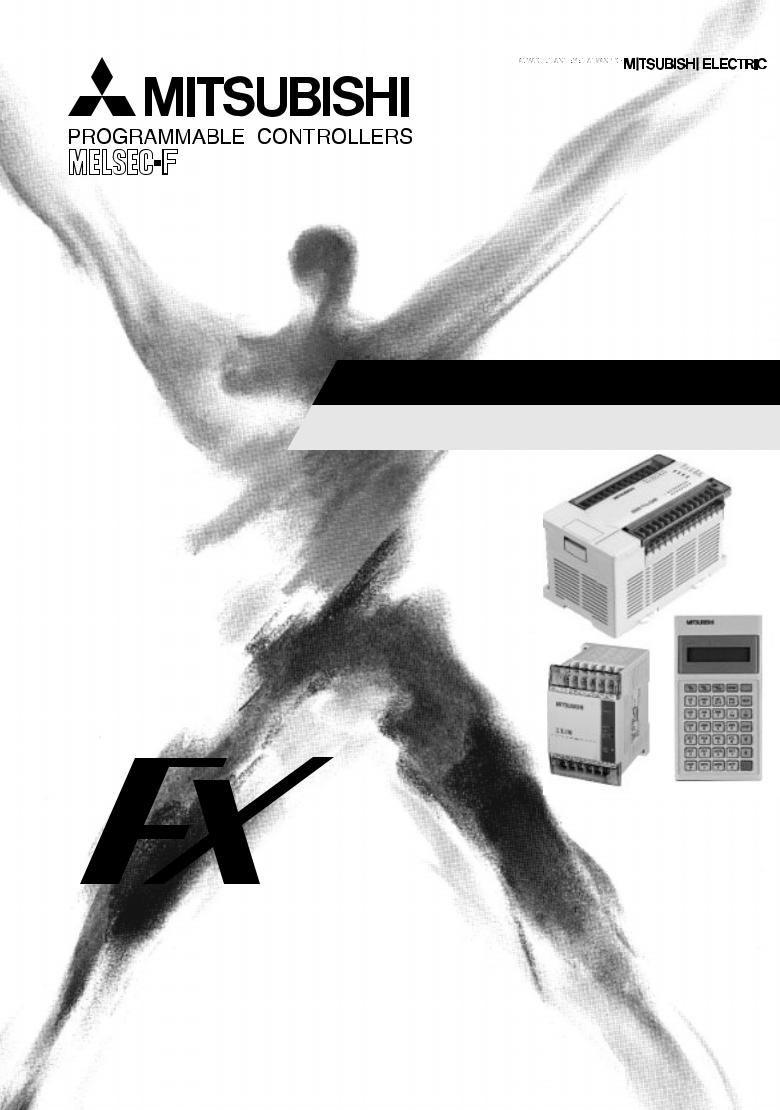
PROGRAMMING MANUAL II
THE FX SERIES OF PROGRAMMABLE CONTROLLER
(FX1S, FX1N, FX2N, FX2NC)

FX Series Programmable Controllers
FX Series Programmable Controllers
Programming Manual
Manual number : JY992D88101
Manual revision : A
Date |
: April 2000 |
Foreword
•This manual contains text, diagrams and explanations which will guide the reader in the correct programming and operation of the PLC.
•Before attempting to install or use the PLC this manual should be read and understood.
•If in doubt at any stage of the installation of the PLC always consult a professional electrical engineer who is qualified and trained to the local and national standards which apply to the installation site.
•If in doubt about the operation or use of the PLC please consult the nearest Mitsubishi Electric distributor.
•This manual is subject to change without notice.
i

FX Series Programmable Controllers
ii

FX Series Programmable Controllers
FAX BACK - Combined Programming Manual (J)
Mitsubishi has a world wide reputation for its efforts in continually developing and pushing back the frontiers of industrial automation. What is sometimes overlooked by the user is the care and attention to detail that is taken with the documentation. However,to continue this process of improvement, the comments of the Mitsubishi users are always welcomed. This page has been designed for you,the reader,to fill in your comments and fax them back to us. We look forward to hearing from you.
Please tick the box of your choice;
Fax numbers: |
|
|
Your name.................................................... |
Mitsubishi Electric |
.... |
|
..................................................................... |
America |
(01) |
847-478-2253 |
Your company .............................................. |
Australia |
(02) |
638-7072 |
..................................................................... |
Germany |
(0 21 02) 4 86-1 12 |
Your location: ............................................... |
|
South Africa |
(0111) 444-8304 |
..................................................................... |
|
United Kingdom |
(01707) 278-695 |
|
|
What condition did the manual arrive in? |
Good |
Minor damage |
Unusable |
Will you be using a folder to store the manual? |
|
Yes |
No |
What do you think to the manual presentation? |
Tidy |
Un-friendly |
|
Are the explanations understandable? |
Yes |
Not too bad |
Unusable |
Which explanation was most difficult to understand: ..................................................................
....................................................................................................................................................
Are there any diagrams which are not clear? |
Yes |
No |
If so,which:.................................................................................................................................. |
|
|
What do you think to the manual layout? |
Good Not too bad |
Un-helpful |
If there one thing you would like to see improved,what is it?......................................................
....................................................................................................................................................
....................................................................................................................................................
Could you find the information you required easily using the index and/or the contents,if possi-
ble please identify your experience: ...........................................................................................
....................................................................................................................................................
....................................................................................................................................................
....................................................................................................................................................
....................................................................................................................................................
Do you have any comments in general about the Mitsubishi manuals? .....................................
....................................................................................................................................................
....................................................................................................................................................
....................................................................................................................................................
....................................................................................................................................................
Thank you for taking the time to fill out this questionnaire. We hope you found both the product and this manual easy to use.
iii

FX Series Programmable Controllers
iv

FX Series Programmable Controllers
Guidelines for the Safety of the User and Protection of the Programmable Controller (PLC)
This manual provides information for the use of the FX family of PLC’s. The manual has been written to be used by trained and competent personnel. The definition of such a person or persons is as follows;
a)Any engineer who is responsible for the planning, design and construction of automatic equipment using the product associated with this manual should be of a competent nature, trained and qualified to the local and national standards required to fulfill that role. These engineers should be fully aware of all aspects of safety with regards to automated equipment.
b)Any commissioning or service engineer must be of a competent nature, trained and qualified to the local and national standards required to fulfill that job. These engineers should also be trained in the use and maintenance of the completed product. This includes being completely familiar with all associated documentation for the said product. All maintenance should be carried out in accordance with established safety practices.
c)All operators of the completed equipment should be trained to use that product in a safe and coordinated manner in compliance to established safety practices. The operators should also be familiar with documentation which is connected with the actual operation of the completed equipment.
Note : the term ‘completed equipment’ refers to a third party constructed device which contains or uses the product associated with this manual.
Note’s on the Symbols used in this Manual
At various times through out this manual certain symbols will be used to highlight points of information which are intended to ensure the users personal safety and protect the integrity of equipment. Whenever any of the following symbols are encountered its associated note must be read and understood. Each of the symbols used will now be listed with a brief description of its meaning.
Hardware Warnings
1)Indicates that the identified danger WILL cause physical and property damage.
2)Indicates that the identified danger could POSSIBLY cause physical and property damage.
3)Indicates a point of further interest or further explanation.
Software Warnings
4) Indicates special care must be taken when using this element of software.
5) Indicates a special point which the user of the associate software element should be aware of.
6) Indicates a point of interest or further explanation.
v

FX Series Programmable Controllers
vi

FX Series Programmable controllers
Contents |
|
|
1. Introduction............................................................................................ |
1-1 |
|
1.1 |
Overview.............................................................................................................. |
1-1 |
1.2 |
What is a Programmable Controller? .................................................................. |
1-2 |
1.3 |
What do You Need to Program a PLC? .............................................................. |
1-2 |
1.4 |
Special considerations for programming equipment ........................................... |
1-3 |
1.4.1 Current Generation CPU all versions ....................................................................... |
1-3 |
|
1.5 |
Assocciated Manuals........................................................................................... |
1-4 |
2. Basic Program Instructions ................................................................... |
2-1 |
|
2.1 |
What is a Program? ............................................................................................. |
2-1 |
2.2 |
Outline of Basic Devices Used in Programming .................................................. |
2-1 |
2.3 |
How to Read Ladder Logic .................................................................................. |
2-2 |
2.4 |
Load, Load Inverse.............................................................................................. |
2-3 |
2.5 |
Out....................................................................................................................... |
2-4 |
2.5.1 Timer and Counter Variations ................................................................................... |
2-4 |
|
2.5.2 Double Coil Designation ............................................................................................ |
2-5 |
|
2.6 |
And, And Inverse ................................................................................................. |
2-6 |
2.7 |
Or, Or Inverse ...................................................................................................... |
2-7 |
2.8 |
Load Pulse, Load Trailing Pulse.......................................................................... |
2-8 |
2.9 |
And Pulse, And Trailing Pulse ............................................................................. |
2-9 |
2.10 |
Or Pulse, Or Trailing Pulse ................................................................................ |
2-10 |
2.11 |
Or Block............................................................................................................. |
2-11 |
2.12 |
And Block .......................................................................................................... |
2-12 |
2.13 |
MPS, MRD and MPP ......................................................................................... |
2-13 |
2.14 |
Master Control and Reset.................................................................................. |
2-15 |
2.15 |
Set and Reset.................................................................................................... |
2-17 |
2.16 |
Timer, Counter (Out & Reset)............................................................................ |
2-18 |
2.16.1 Basic Timers, Retentive Timers And Counters........................................................ |
2-18 |
|
2.16.2 Normal 32 bit Counters ........................................................................................... |
2-19 |
|
2.16.3 High Speed Counters .............................................................................................. |
2-19 |
|
2.17 |
Leading and Trailing Pulse ................................................................................ |
2-20 |
2.18 |
Inverse ............................................................................................................... |
2-21 |
2.19 |
No Operation ..................................................................................................... |
2-22 |
2.20 |
End .................................................................................................................... |
2-23 |
i

3. STL Programming ................................................................................. |
3-1 |
||
3.1 |
What is STL, SFC And IEC1131 Part 3?............................................................. |
3-1 |
|
3.2 |
How STL Operates .............................................................................................. |
3-2 |
|
3.2.1 |
Each step is a program ............................................................................................. |
3-2 |
|
3.3 |
How To Start And End An STL Program ............................................................. |
3-3 |
|
3.3.1 |
Embedded STL programs ......................................................................................... |
3-3 |
|
3.3.2 |
Activating new states................................................................................................. |
3-3 |
|
3.3.3 |
Terminating an STL Program .................................................................................... |
3-4 |
|
3.4 |
Moving Between STL Steps ................................................................................ |
3-5 |
|
3.4.1 |
Using SET to drive an STL coil ................................................................................. |
3-5 |
|
3.4.2 |
Using OUT to drive an STL coil ................................................................................. |
3-6 |
|
3.5 |
Rules and Techniques For STL programs........................................................... |
3-7 |
|
3.5.1 |
Basic Notes On The Behavior Of STL programs....................................................... |
3-7 |
|
3.5.2 |
Single Signal Step Control ........................................................................................ |
3-9 |
|
3.6 |
Restrictions Of Some Instructions When Used With STL.................................. |
3-10 |
|
3.7 |
Using STL To Select The Most Appropriate Program ....................................... |
3-11 |
|
3.8 |
Using STL To Activate Multiple Flows Simultaneously...................................... |
3-12 |
|
3.9 |
General Rules For Successful STL Branching .................................................. |
3-14 |
|
3.10 |
General Precautions When Using The FX-PCS/AT-EE Software ..................... |
3-15 |
|
3.11 |
Programming Examples .................................................................................... |
3-16 |
|
3.11.1 A Simple STL Flow .................................................................................................. |
3-16 |
||
3.11.2 A Selective Branch/ First State Merge Example Program....................................... |
3-18 |
||
3.12 |
Advanced STL Use............................................................................................ |
3-20 |
|
4. Devices in Detail.................................................................................... |
4-1 |
||
4.1 |
Inputs................................................................................................................... |
4-1 |
|
4.2 |
Outputs ................................................................................................................ |
4-2 |
|
4.3 |
Auxiliary Relays ................................................................................................... |
4-3 |
|
4.3.1 |
General Stable State Auxiliary Relays ...................................................................... |
4-3 |
|
4.3.2 |
Battery Backed/ Latched Auxiliary Relays................................................................. |
4-4 |
|
4.3.3 |
Special Diagnostic Auxiliary Relays .......................................................................... |
4-5 |
|
4.3.4 |
Special Single Operation Pulse Relays ..................................................................... |
4-5 |
|
4.4 |
State Relays ........................................................................................................ |
4-6 |
|
4.4.1 |
General Stable State - State Relays ......................................................................... |
4-6 |
|
4.4.2 |
Battery Backed/ Latched State Relays ...................................................................... |
4-7 |
|
4.4.3 |
STL Step Relays ....................................................................................................... |
4-8 |
|
4.4.4 |
Annunciator Flags ..................................................................................................... |
4-9 |
|
4.5 |
Pointers ............................................................................................................. |
4-10 |
|
4.6 |
Interrupt Pointers ............................................................................................... |
4-11 |
|
4.6.1 |
Input Interrupts ........................................................................................................ |
4-12 |
|
4.6.2 |
Timer Interrupts ....................................................................................................... |
4-12 |
|
4.6.3 |
Disabling Individual Interrupts ................................................................................. |
4-13 |
|
4.6.4 |
Counter Interrupts ................................................................................................... |
4-13 |
|
4.7 |
Constant K......................................................................................................... |
4-14 |
|
4.8 |
Constant H......................................................................................................... |
4-14 |
|
4.9 |
Timers................................................................................................................ |
4-15 |
|
4.9.1 |
General timer operation........................................................................................... |
4-16 |
|
4.9.2 |
Selectable Timers.................................................................................................... |
4-16 |
|
4.9.3 |
Retentive Timers ..................................................................................................... |
4-17 |
|
4.9.4 |
Timers Used in Interrupt and ‘CALL’ Subroutines ................................................... |
4-18 |
|
4.9.5 |
Timer Accuracy ....................................................................................................... |
4-18 |
|
4.10 Counters ............................................................................................................ |
4-19 |
||
4.10.1 General/ Latched 16bit UP Counters ...................................................................... |
4-20 |
||
4.10.2 General/ Latched 32bit Bi-directional Counters....................................................... |
4-21 |
||
ii

4.11 High Speed Counters ........................................................................................ |
4-22 |
4.11.1 Basic High Speed Counter Operation ..................................................................... |
4-23 |
4.11.2 Availability of High Speed Counters ....................................................................... |
4-24 |
4.11.3 1 Phase Counters - User Start and Reset (C235 - C240) ....................................... |
4-26 |
4.11.4 1 Phase Counters - Assigned Start and Reset (C241 to C245) .............................. |
4-27 |
4.11.5 2 Phase Bi-directional Counters (C246 to C250) .................................................... |
4-28 |
4.11.6 A/B Phase Counters (C252 to C255) ...................................................................... |
4-29 |
4.12 Data Registers................................................................................................... |
4-30 |
4.12.1 General Use Registers ............................................................................................ |
4-31 |
4.12.2 Battery Backed/ Latched Registers ......................................................................... |
4-32 |
4.12.3 Special Diagnostic Registers................................................................................... |
4-32 |
4.12.4 File Registers .......................................................................................................... |
4-33 |
4.12.5 Externally Adjusted Registers ................................................................................. |
4-34 |
4.13 Index Registers.................................................................................................. |
4-35 |
4.13.1 Modifying a Constant............................................................................................... |
4-36 |
4.13.2 Misuse of the Modifiers ........................................................................................... |
4-36 |
4.13.3 Using Multiple Index Registers ................................................................................ |
4-36 |
4.14 Bits, Words, BCD and Hexadecimal.................................................................. |
4-37 |
4.14.1 Bit Devices, Individual and Grouped ....................................................................... |
4-37 |
4.14.2 Word Devices .......................................................................................................... |
4-39 |
4.14.3 Interpreting Word Data ............................................................................................ |
4-39 |
4.14.4 Two’s Compliment ................................................................................................... |
4-42 |
4.15 Floating Point And Scientific Notation ............................................................... |
4-43 |
4.15.1 Scientific Notation.................................................................................................... |
4-44 |
4.15.2 Floating Point Format .............................................................................................. |
4-45 |
4.15.3 Summary Of The Scientific Notation and Floating Point Numbers.......................... |
4-46 |
5. Applied Instructions ............................................................................... |
5-1 |
|
5.1 Program Flow-Functions 00 to 09 ....................................................................... |
5-4 |
|
5.1.1 |
CJ (FNC 00) .............................................................................................................. |
5-5 |
5.1.2 |
CALL (FNC 01).......................................................................................................... |
5-7 |
5.1.3 |
SRET (FNC 02) ......................................................................................................... |
5-8 |
5.1.4 |
IRET, EI, DI (FNC 03, 04, 05) ................................................................................... |
5-9 |
5.1.5 |
FEND (FNC 06) ....................................................................................................... |
5-11 |
5.1.6 |
WDT (FNC 07) ........................................................................................................ |
5-12 |
5.1.7 |
FOR, NEXT (FNC 08, 09) ....................................................................................... |
5-13 |
5.2 Move And Compare - Functions 10 to 19 .......................................................... |
5-16 |
|
5.2.1 |
CMP (FNC 10)......................................................................................................... |
5-17 |
5.2.2 |
ZCP (FNC 11) ......................................................................................................... |
5-17 |
5.2.3 |
MOV (FNC 12) ........................................................................................................ |
5-18 |
5.2.4 |
SMOV (FNC 13) ...................................................................................................... |
5-18 |
5.2.5 |
CML (FNC 14) ......................................................................................................... |
5-19 |
5.2.6 |
BMOV (FNC 15) ..................................................................................................... |
5-20 |
5.2.7 |
FMOV (FNC 16) ...................................................................................................... |
5-21 |
5.2.8 |
XCH (FNC 17) ......................................................................................................... |
5-21 |
5.2.9 |
BCD (FNC18) .......................................................................................................... |
5-22 |
5.2.10 BIN (FNC 19)........................................................................................................... |
5-22 |
|
5.3 Arithmetic And Logical Operations - Functions 20 to 29 ................................... |
5-24 |
|
5.3.1 |
ADD (FNC 20) ......................................................................................................... |
5-25 |
5.3.2 |
SUB (FNC 21) ........................................................................................................ |
5-26 |
5.3.3 |
MUL (FNC 22) ......................................................................................................... |
5-27 |
5.3.4 |
DIV (FNC 23)........................................................................................................... |
5-28 |
5.3.5 |
INC (FNC 24) ......................................................................................................... |
5-29 |
5.3.6 |
DEC (FNC 24) ........................................................................................................ |
5-29 |
5.3.7 |
WAND (FNC 26)...................................................................................................... |
5-30 |
5.3.8 |
WOR (FNC 27) ........................................................................................................ |
5-30 |
iii

5.3.9 |
WXOR (FNC 28) ..................................................................................................... |
5-31 |
5.3.10 NEG (FNC 29) ........................................................................................................ |
5-31 |
|
5.4 Rotation And Shift - Functions 30 to 39............................................................. |
5-34 |
|
5.4.1 |
ROR (FNC 30)......................................................................................................... |
5-35 |
5.4.2 |
ROL (FNC 31) ......................................................................................................... |
5-35 |
5.4.3 |
RCR (FNC 32) ......................................................................................................... |
5-36 |
5.4.4 |
RCL (FNC 33) ......................................................................................................... |
5-36 |
5.4.5 |
SFTR (FNC 34) ....................................................................................................... |
5-37 |
5.4.6 |
SFTL (FNC 35) ........................................................................................................ |
5-37 |
5.4.7 |
WSFR (FNC 36) ...................................................................................................... |
5-38 |
5.4.8 |
WSFL (FNC 37)....................................................................................................... |
5-38 |
5.4.9 |
SFWR (FNC 38) ...................................................................................................... |
5-39 |
5.4.10 SFRD (FNC 39) ....................................................................................................... |
5-40 |
|
5.5 Data Operation - Functions 40 to 49 ................................................................. |
5-42 |
|
5.5.1 |
ZRST (FNC 40) ....................................................................................................... |
5-43 |
5.5.2 |
DECO (FNC 41) ...................................................................................................... |
5-43 |
5.5.3 |
ENCO (FNC 42) ...................................................................................................... |
5-44 |
5.5.4 |
SUM (FNC 43)......................................................................................................... |
5-45 |
5.5.5 |
BON (FNC 44) ......................................................................................................... |
5-45 |
5.5.6 |
MEAN (FNC 45) ...................................................................................................... |
5-46 |
5.5.7 |
ANS (FNC 46) ......................................................................................................... |
5-47 |
5.5.8 |
ANR (FNC 47) ......................................................................................................... |
5-47 |
5.5.9 |
SQR (FNC 48) ......................................................................................................... |
5-48 |
5.5.10 FLT (FNC 49) .......................................................................................................... |
5-49 |
|
5.6 High Speed Processing - Functions 50 to 59 .................................................... |
5-52 |
|
5.6.1 |
REF (FNC 50) ......................................................................................................... |
5-53 |
5.6.2 |
REFF (FNC 51) ....................................................................................................... |
5-53 |
5.6.3 |
MTR (FNC 52) ......................................................................................................... |
5-54 |
5.6.4 |
HSCS (FNC 53)....................................................................................................... |
5-55 |
5.6.5 |
HSCR (FNC 54) ...................................................................................................... |
5-56 |
5.6.6 |
HSZ (FNC 55) ......................................................................................................... |
5-57 |
5.6.7 |
SPD (FNC 56) ......................................................................................................... |
5-60 |
5.6.8 |
PLSY (FNC 57) ....................................................................................................... |
5-61 |
5.6.9 |
PWM (FNC 58) ........................................................................................................ |
5-62 |
5.6.10 PLSR (FNC 59) ....................................................................................................... |
5-63 |
|
5.7 Handy Instructions - Functions 60 to 69 ............................................................ |
5-66 |
|
5.7.1 |
IST (FNC 60) ........................................................................................................... |
5-67 |
5.7.2 |
SER (FNC 61) ......................................................................................................... |
5-69 |
5.7.3 |
ABSD (FNC 62) ....................................................................................................... |
5-70 |
5.7.4 |
INCD (FNC 63) ........................................................................................................ |
5-71 |
5.7.5 |
TTMR (FNC 64)....................................................................................................... |
5-72 |
5.7.6 |
STMR (FNC 65) ...................................................................................................... |
5-72 |
5.7.7 |
ALT (FNC 66) .......................................................................................................... |
5-73 |
5.7.8 |
RAMP (FNC 67) ...................................................................................................... |
5-73 |
5.7.9 |
ROTC (FNC 68) ...................................................................................................... |
5-75 |
5.7.10 SORT (FNC 69)....................................................................................................... |
5-77 |
|
5.8 External FX I/O Devices - Functions 70 to 79 ................................................... |
5-80 |
|
5.8.1 |
TKY (FNC 70).......................................................................................................... |
5-81 |
5.8.2 |
HKY (FNC 71) ......................................................................................................... |
5-82 |
5.8.3 |
DSW (FNC 72) ........................................................................................................ |
5-83 |
5.8.4 |
SEGD (FNC 73) ...................................................................................................... |
5-84 |
5.8.5 |
SEGL (FNC 74) ....................................................................................................... |
5-85 |
5.8.6 |
ARWS (FNC 75) ...................................................................................................... |
5-87 |
5.8.7 |
ASC (FNC 76) ......................................................................................................... |
5-88 |
5.8.8 |
PR (FNC 77)............................................................................................................ |
5-89 |
5.8.9 |
FROM (FNC 78) ...................................................................................................... |
5-90 |
5.8.10 |
TO (FNC 79)............................................................................................................ |
5-91 |
iv

5.9 External FX Serial Devices - Functions 80 to 89 ............................................... |
5-94 |
|
5.9.1 |
RS (FNC 80)............................................................................................................ |
5-95 |
5.9.2 |
RUN (FNC 81) ......................................................................................................... |
5-96 |
5.9.3 |
ASCI (FNC 82) ........................................................................................................ |
5-98 |
5.9.4 |
HEX (FNC 83) ......................................................................................................... |
5-99 |
5.9.5 |
CCD (FNC 84) ....................................................................................................... |
5-100 |
5.9.6 |
VRRD (FNC 85) .................................................................................................... |
5-101 |
5.9.7 |
VRSD (FNC 86)..................................................................................................... |
5-101 |
5.9.8 |
PID (FNC 88)......................................................................................................... |
5-102 |
5.10 Floating Point 1 & 2 - Functions 110 to 129 .................................................... |
5-110 |
|
5.10.1 ECMP (FNC 110) .................................................................................................. |
5-111 |
|
5.10.2 EZCP (FNC 111) ................................................................................................... |
5-111 |
|
5.10.3 EBCD (FNC 118)................................................................................................... |
5-112 |
|
5.10.4 EBIN (FNC 119) .................................................................................................... |
5-112 |
|
5.10.5 EADD (FNC 120)................................................................................................... |
5-113 |
|
5.10.6 EAUB (FNC 121) ................................................................................................... |
5-114 |
|
5.10.7 EMUL (FNC 122)................................................................................................... |
5-114 |
|
5.10.8 EDIV (FNC 123) .................................................................................................... |
5-115 |
|
5.10.9 ESQR (FNC 127) .................................................................................................. |
5-115 |
|
5.10.10INT (FNC 129) ...................................................................................................... |
5-116 |
|
5.11 Trigonometry - FNC 130 to FNC 139 .............................................................. |
5-118 |
|
5.11.1 SIN (FNC 130)....................................................................................................... |
5-119 |
|
5.11.2 COS (FNC 131) ..................................................................................................... |
5-120 |
|
5.11.3 TAN (FNC 132) ..................................................................................................... |
5-120 |
|
5.12 Data Operations 2 - FNC 140 to FNC 149 ...................................................... |
5-122 |
|
5.12.1 SWAP (FNC 147) .................................................................................................. |
5-123 |
|
5.13 FX1S & FX1N Positioning Control - FNC 150 to FNC 159 .............................. |
5-126 |
|
5.13.1 ABS (FNC 155) ..................................................................................................... |
5-127 |
|
5.13.2 ZRN (FNC 156) ..................................................................................................... |
5-128 |
|
5.13.3 PLSV(FNC157) ..................................................................................................... |
5-129 |
|
5.13.4 DRVI (FNC 158) .................................................................................................... |
5-130 |
|
5.13.5 DRVA(FNC 159).................................................................................................... |
5-132 |
|
5.14 Real Time Clock Control - FNC 160 to FNC 169............................................. |
5-136 |
|
5.14.1 TCMP (FNC 160) .................................................................................................. |
5-137 |
|
5.14.2 TZCP (FNC 161) ................................................................................................... |
5-138 |
|
5.14.3 TADD (FNC 162) ................................................................................................... |
5-139 |
|
5.14.4 TSUB (FNC 163) ................................................................................................... |
5-140 |
|
5.14.5 TRD (FNC 166) ..................................................................................................... |
5-141 |
|
5.14.6 TWR (FNC 167) .................................................................................................... |
5-142 |
|
5.14.7 Hour(FNC 169) ...................................................................................................... |
5-143 |
|
5.15 Gray Codes - FNC 170 to FNC 179 ................................................................ |
5-146 |
|
5.15.1 GRY (FNC 170) ..................................................................................................... |
5-147 |
|
5.15.2 GBIN (FNC 171) .................................................................................................... |
5-147 |
|
5.15.3 RD3A (FNC 176) ................................................................................................... |
5-148 |
|
5.15.4 WR3A (FNC 177) .................................................................................................. |
5-148 |
|
5.16 Inline Comparisons - FNC 220 to FNC 249 ..................................................... |
5-150 |
|
5.16.1 LD compare (FNC 224 to 230) .............................................................................. |
5-151 |
|
5.16.2 AND compare (FNC 232 to 238) ........................................................................... |
5-152 |
|
5.16.3 OR compare (FNC 240 to 246) ............................................................................. |
5-153 |
|
v

6. Diagnostic Devices................................................................................ |
6-1 |
|
6.1 |
PLC Status (M8000 to M8009 and D8000 to D8009).......................................... |
6-2 |
6.2 |
Clock Devices (M8010 to M8019 and D8010 to D8019) .................................... |
6-3 |
6.3 |
Operation Flags ................................................................................................... |
6-4 |
6.4 |
PLC Operation Mode (M8030 to M8039 and D8030 to D8039) ......................... |
6-5 |
6.5 |
Step Ladder (STL) Flags (M8040 to M8049 and D8040 to D8049) .................... |
6-6 |
6.6 |
Interrupt Control Flags (M8050 to M8059 and D8050 to D8059) ...................... |
6-7 |
6.7 |
Error Detection Devices (M8060 to M8069 and D8060 to D6069) ..................... |
6-8 |
6.8 |
Link and Special Operation Devices (M8070 to M8099 and D8070 to D8099) .. |
6-9 |
6.9 |
Miscellaneous Devices (M8100 to M8119 and D8100 to D8119) ..................... |
6-10 |
6.10 |
Communication Adapter Devices, i.e. 232ADP, 485ADP.................................. |
6-10 |
6.11 |
High Speed Zone Compare Table Comparison Flags....................................... |
6-11 |
6.12 |
Miscellaneous Devices (M8160 to M8199) ....................................................... |
6-12 |
6.13 |
Index Registers (D8180 to D8199) ................................................................... |
6-13 |
6.14 |
Up/Down Counter Control (M8200 to M8234 and M8200 to D8234) ............... |
6-14 |
6.15 |
High Speed Counter Control (M8235 to M8255 and D8235 to D8255) ............ |
6-14 |
6.16 |
Error Code Tables ............................................................................................. |
6-15 |
7. Execution Times And Instructional |
|
|
Hierarchy ............................................................................................... |
7-1 |
|
7.1 |
Basic Instructions ................................................................................................ |
7-1 |
7.2 |
Applied Instructions ............................................................................................ |
7-3 |
7.3 |
Hierarchical Relationships Of Basic Program Instructions ................................ |
7-11 |
7.4 |
Batch Processing............................................................................................... |
7-13 |
7.5 |
Summary of Device Memory Allocations ........................................................... |
7-13 |
7.6 |
Limits Of Instruction Usage ............................................................................... |
7-14 |
7.6.1 Instructions Which Can Only Be Used Once In The Main Program Area ............... |
7-14 |
|
7.6.2 Instructions Which Are Not Suitable For Use With 110V AC Input Units ................ |
7-15 |
|
8. PLC Device Tables................................................................................ |
8-1 |
|
8.1 |
Performance Specification Of The FX1S ............................................................ |
8-1 |
8.2 |
Performance Specification Of The FX1N ............................................................ |
8-2 |
8.3 |
Performance Specification Of The FX2N and the FX2NC PLC’s ........................ |
8-4 |
9. Assigning System Devices .................................................................... |
9-1 |
|
9.1 |
Addressing Extension Modules ........................................................................... |
9-1 |
9.2 |
Real Time Clock Function ................................................................................... |
9-2 |
9.2.1 Setting the real time clock ......................................................................................... |
9-2 |
|
vi

10.Points Of Technique........................................................................... |
10-1 |
|
10.1 |
Advanced Programming Points ......................................................................... |
10-1 |
10.2 |
Users of DC Powered FX Units ......................................................................... |
10-1 |
10.3 |
Using The Forced RUN/STOP Flags................................................................. |
10-2 |
10.3.1 A RUN/STOP push button configuration ................................................................. |
10-2 |
|
10.3.2 Remote RUN/STOP control .................................................................................... |
10-3 |
|
10.4 |
Constant Scan Mode ......................................................................................... |
10-4 |
10.5 |
Alternating ON/OFF States................................................................................ |
10-4 |
10.6 |
Using Battery Backed Devices For Maximum Advantage ................................. |
10-5 |
10.7 |
Indexing Through Multiple Display Data Values ................................................ |
10-5 |
10.8 |
Reading And Manipulating Thumbwheel Data .................................................. |
10-6 |
10.9 |
Measuring a High Speed Pulse Input ................................................................ |
10-6 |
10.9.1 A 1 msec timer pulse measurement ........................................................................ |
10-6 |
|
10.9.2 A 0.1 msec timer pulse measurement ..................................................................... |
10-7 |
|
10.10Using The Execution Complete Flag, M8029 ................................................... |
10-7 |
|
10.11Creating a User Defined MTR Instruction ......................................................... |
10-8 |
|
10.12An Example System Application Using STL And IST Program Control............ |
10-8 |
|
10.13Using The PWM Instruction For Motor Control ............................................... |
10-15 |
|
10.14Communication Format................................................................................... |
10-18 |
|
10.14.1Specification of the communication parameters: .................................................. |
10-18 |
|
10.14.2Header and Terminator Characters ...................................................................... |
10-19 |
|
10.14.3Timing diagrams for communications: .................................................................. |
10-20 |
|
10.14.48 bit or 16 bit communications.............................................................................. |
10-23 |
|
10.15PID Programming Techniques........................................................................ |
10-24 |
|
10.15.1Keeping MV within a set range ............................................................................. |
10-24 |
|
10.15.2Manual/Automatic change over ............................................................................ |
10-24 |
|
10.15.3Using the PID alarm signals ................................................................................. |
10-25 |
|
10.15.4Other tips for PID programming............................................................................ |
10-25 |
|
10.16Additional PID functions.................................................................................. |
10-26 |
|
10.16.1Output Value range control (S3+1 b5).................................................................. |
10-26 |
|
10.17Pre-tuning operation ....................................................................................... |
10-27 |
|
10.17.1Variable Constants ............................................................................................... |
10-27 |
|
10.18Example Autotuning Program ......................................................................... |
10-28 |
|
10.19Using the FX1N-5DM Display module. ........................................................... |
10-29 |
|
10.19.1Outline of functions. .............................................................................................. |
10-29 |
|
10.19.2Control devices for 5DM ....................................................................................... |
10-30 |
|
10.19.3Display screen protect function............................................................................. |
10-30 |
|
10.19.4Specified device monitor....................................................................................... |
10-31 |
|
10.19.5Specified device edit............................................................................................. |
10-32 |
|
10.19.6Automatic Backlight OFF ...................................................................................... |
10-33 |
|
10.19.7Error display enable / disable ............................................................................... |
10-33 |
|
1. Index.................................................................................................... |
11-1 |
|
1.1 |
Index.................................................................................................................. |
11-1 |
1.2 |
ASCII Character Codes ..................................................................................... |
11-9 |
1.3 |
Applied Instruction List .................................................................................... |
11-10 |
vii

viii
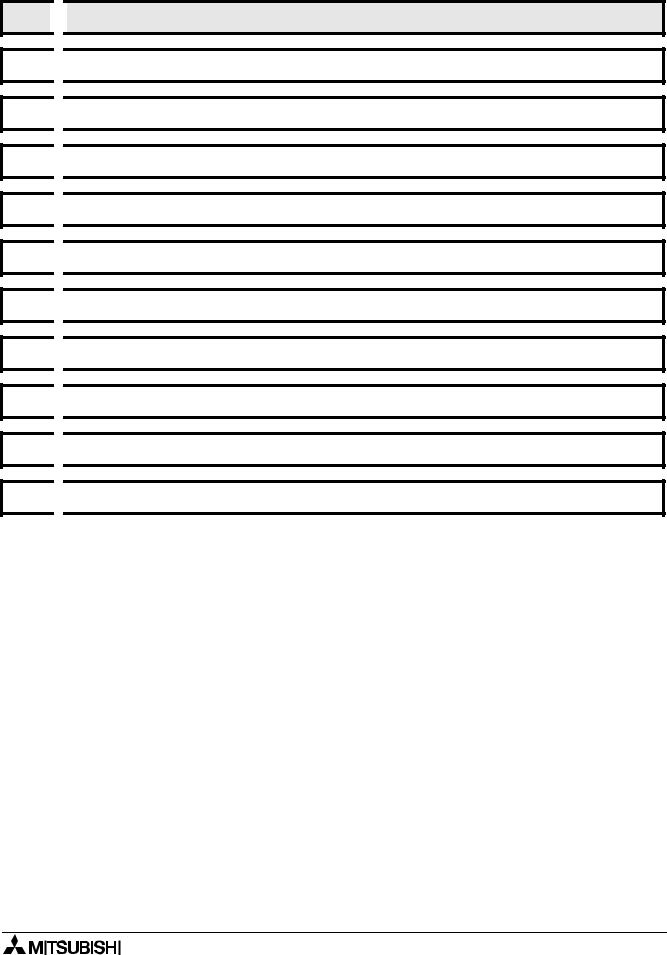
FX Series Programmable Controllers |
Introduction 1 |
1
 Introduction
Introduction
2
 Basic Program Instructions
Basic Program Instructions
3
 STL Programming
STL Programming
4
 Devices in Detail
Devices in Detail
5
 Applied Instructions
Applied Instructions
6
 Diagnostic Devices
Diagnostic Devices
7
 Instruction Execution Times
Instruction Execution Times
8
 PLC Device Tables
PLC Device Tables
9
 Assigning System Devices 10
Assigning System Devices 10 
 Points of Technique
Points of Technique
11 
 Index
Index

FX Series Programmable Controllers Introduction 1
Chapter Contents |
|
|
1. Introduction............................................................................................ |
1-1 |
|
1.1 |
Overview.............................................................................................................. |
1-1 |
1.2 |
What is a ProgrammableController? ................................................................... |
1-2 |
1.3 |
What do You Need to Program a PC? ................................................................ |
1-2 |
1.4 |
Curent Generation CPU’s, All versions ............................................................... |
1-3 |
1.5 |
Associated Manuals ............................................................................................ |
1-4 |
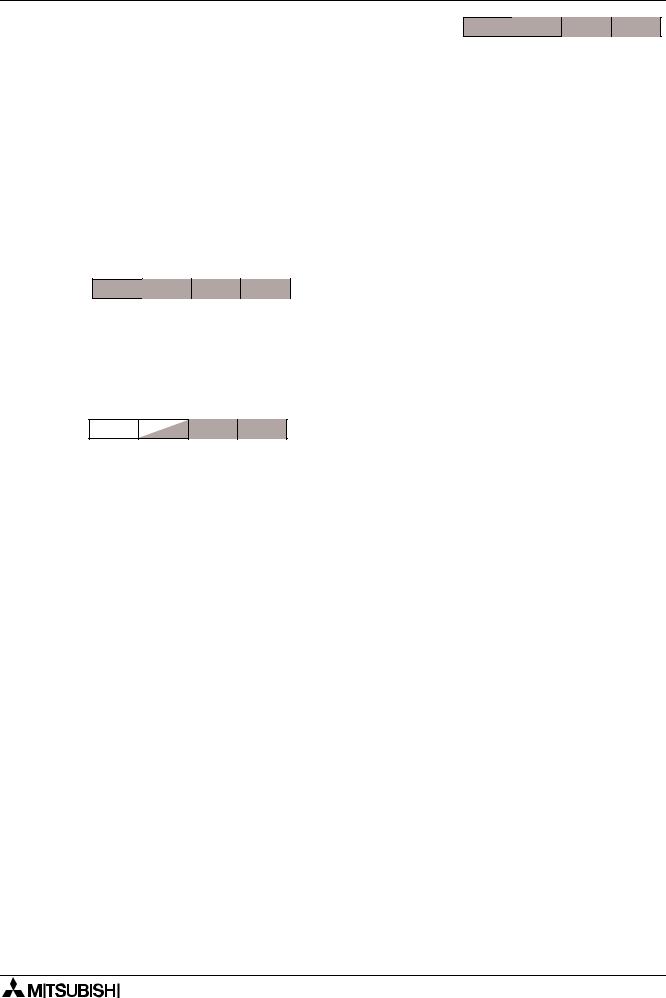
Introduction 1
FX1S |
FX1N |
FX2N |
FX2NC |
1.Introduction
1.1Overview
1)Scope of this manual
This manual gives details on all aspects of operation and programming for FX1S, FX1N, FX2N and FX2NC programmable controllers (PLCs). For all information relating to the PLC hardware and installation, refer to the appropriate manual supplied with the unit.
2)How to use this manual
This manual covers all the functions of the highest specification Programmable (Logic) Controller (PLC). For this reason, the following indicator is included in relevant section titles to show which PLCs that section applies to;
FX1S |
FX1N |
FX2N |
FX2NC |
Shaded boxes indicate the applicable PLC type
3)FX family
This is a generic term which is often used to describe all Programmable Controllers without identifying individual types or model names.
4)CPU version numbers and programming support
As Mitsubishi upgrades each model different versions have different capabilities. - Please refer to section 1.4 for details about peripheral support for each model.
1-1

Introduction 1
1.2What is a Programmable Controller?
FX1S |
FX1N |
FX2N |
FX2NC |
A Programmable Logic Controller (PLC or programmable controller) is a device that a user can program to perform a series or sequence of events. These events are triggered by stimuli (usually called inputs) received at the PLC or through delayed actions such as time delays or counted occur-rences. Once an event triggers, it actuates in the outside world by switching ON or OFF electronic control gear or the physical actuation of devices. A programmable controller will continually ‘loop’ through its internal ‘user defined’ program waiting for inputs and giving outputs at the programmed specific times.
Note on terminology:
The term programmable controller is a generic word used to bring all the elements making the control system under one descriptive name. Sometimes engineers use the term ‘Programmable Logic Controller’, ‘PLC’ or ‘programmable controller’ to describe the same control system.
The construction of a programmable controller can be broken down into component parts. The element where the program is loaded, stored and processed is often known as the Main Processing Unit or MPU. Other terms commonly heard to describe this device are ‘base unit’, ‘controller’ and ‘CPU’. The term CPU is a little misleading as todays more advanced products may contain local CPU devices. A Main CPU (or more correctly a Main Processing Unit) controls these local CPUs through a communication network or bus.
1.3What do You Need to Program a PLC?
FX1S |
FX1N |
FX2N |
FX2NC |
A variety of tools are available to program the Mitsubishi FX family of PLCs. Each of these tools can use and access the instructions and devices listed in this manual for the identified PLC.
FX1S
FX1N
FX2N
FX2NC
Opto-isolated
RS232/
RS422 interface
HPP
FX-10P-E
FX-20P-E
Personal computer
Melsec MEDOC
Melsec Medoc Plus
SW1PC-FXGPEE
FX-PCS-WIN-E
1-2
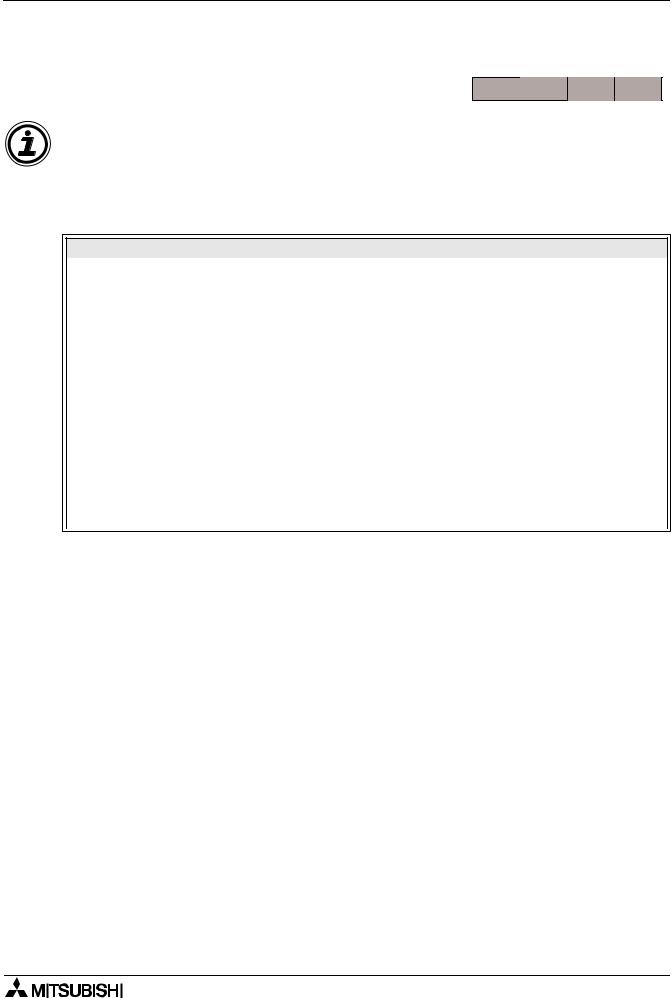
Introduction 1
1.4Special considerations for programming equipment
1.4.1Current Generation CPU all versions
FX1S |
FX1N |
FX2N |
FX2NC |
The introduction of this CPU provides the FX user with many new devices and instructions. To use the full features of the current range of FX units the user must upgrade older software and hardware programming tools.
However, because of the downward compatibility of the current range, it is not necessary to upgrade existing programming tools up to the equivalent functionality of last generation FX CPU ver 3.30 units.
Peripherals Table
Description |
Model Number |
System software version with |
|
full support |
|||
|
|
||
|
|
|
|
Hand held programmer (HHP) |
FX-10P-E |
from V 3.00 |
|
|
|
|
|
HHP cassette |
FX-20P-MFXA-E |
from V 3.00 |
|
|
|
|
|
|
FX-10DU-E |
from V 4.00 |
|
|
|
|
|
|
FX-20DU-E |
Supports up to FX devices only |
|
|
|
|
|
|
FX-25DU-E |
from V 2.00 |
|
|
|
|
|
|
FX-30DU-E |
from V 3.00 |
|
|
|
|
|
Data access units |
FX-40DU-E(S) |
Supports up to FX devices only |
|
|
|
|
|
|
FX-40DU-TK-ES |
from V 3.00 |
|
|
|
|
|
|
FX-50DU-TK(S)-E |
from V 2.10 |
|
|
|
|
|
|
F930GOT-BWD |
All versions |
|
|
|
|
|
|
F940GOT-SWD(LWD)-E |
All versions |
|
|
|
|
1-3

|
|
|
|
|
Introduction 1 |
1.5 |
|
Assocciated Manuals |
|
||
|
|
|
|
|
|
|
|
|
|
Manual name |
Number |
|
|
|
FX Base Unit Hardware |
|
|
|
|
|
|
|
|
|
|
|
FX1S Hardware manual |
JY992D83901 |
|
|
|
|
|
|
|
|
|
|
FX1N Hardware manual |
JY992D88201 |
|
|
|
|
|
|
|
|
|
|
FX2N Hardware manual |
JY992D66301 |
|
|
|
|
|
|
|
|
|
|
FX2NC Hardware manual |
JY992D76401 |
|
|
|
|
|
|
|
|
|
|
FX Programming |
|
|
|
|
|
|
|
|
|
|
|
FX0, FX0S, FX0N, FX, FX2C, FX2N, FX2NC Programming manual |
JY992D48301 |
|
|
|
|
|
|
|
|
|
|
FX1S, FX1N, FX2N, FX2NC Programming manual II |
JY992D88101 |
|
|
|
|
|
|
|
|
|
|
FX Peripherals |
|
|
|
|
|
|
|
|
|
|
|
FX-10P-E Operation manual |
JY992D33401 |
|
|
|
|
|
|
|
|
|
|
FX-20P-E Operation manual |
JY992D19101 |
|
|
|
|
|
|
|
|
|
|
FX-10P, 20P-E Supplimentary manual |
JY992D66901 |
|
|
|
|
|
|
|
|
|
|
FX-PCS-WIN-E Software manual |
JY992D66501 |
|
|
|
|
|
|
|
|
|
|
FX Special Function Blocks |
|
|
|
|
|
|
|
|
|
|
|
FX0N-3A Users guide |
JY992D49001 |
|
|
|
|
|
|
|
|
|
|
FX-4AD Users guide |
JY992D52601 |
|
|
|
|
|
|
|
|
|
|
FX-2AD-PT Users guide |
JY992D55701 |
|
|
|
|
|
|
|
|
|
|
FX-4AD-TC Users guide |
JY992D55901 |
|
|
|
|
|
|
|
|
|
|
FX-2DA Users guide |
JY992D52801 |
|
|
|
|
|
|
|
|
|
|
FX2N-2AD Users manual |
JY992D74701 |
|
|
|
|
|
|
|
|
|
|
FX-4DA Users guide |
JY992D61001 |
|
|
|
|
|
|
|
|
|
|
FX2N-4AD Users guide |
JY992D65201 |
|
|
|
|
|
|
|
|
|
|
FX2N-4AD-TC Users guide |
JY992D65501 |
|
|
|
|
|
|
|
|
|
|
FX2N-4AD-PT Users guide |
JY992D65601 |
|
|
|
|
|
|
|
|
|
|
FX2N-4DA Users guide |
JY992D65901 |
|
|
|
|
|
|
|
|
|
|
FX2N-2DA Users manual |
JY992D74901 |
|
|
|
|
|
|
|
|
|
|
FX2N-2LC Users guide |
JY992D85601 |
|
|
|
|
|
|
|
|
|
|
FX2N-2LC Users manual |
JY992D85801 |
|
|
|
|
|
|
|
|
|
|
FX-485PC-IF Hardware manual |
JY992D81801 |
|
|
|
|
|
|
|
|
|
|
FX/FX0N-485ADP Users guide |
JY992D53201 |
|
|
|
|
|
|
|
|
|
|
FX-232ADP Users guide |
JY992D48801 |
|
|
|
|
|
|
|
|
|
|
FX0N-232ADP Users guide |
JY992D51301 |
|
|
|
|
|
|
|
|
|
|
FX2N-232BD Users guide |
JY992D66001 |
|
|
|
|
|
|
|
|
|
|
FX2N-422BD Users guide |
JY992D66101 |
|
|
|
|
|
|
|
|
|
|
FX2N-485BD Hardware manual |
JY992D73401 |
|
|
|
|
|
|
|
|
|
|
FX2N-232IF Hardware manual |
JY992D73501 |
|
|
|
|
|
|
|
|
|
|
FX Communication Users manual |
JY992D69901 |
|
|
|
|
|
|
|
|
|
|
FX2N-CCL Users manual |
JY992D71801 |
|
|
|
|
|
|
|
|
|
|
FX2N-16LNK-M Users manual |
JY992D73701 |
|
|
|
|
|
|
|
|
|
|
FX0N-32NT-DP Users manual |
JY992D61401 |
|
|
|
|
|
|
|
|
|
|
FX2N-32DP-IF Hardware manual |
JY992D77101 |
|
|
|
|
|
|
|
|
|
|
FX2N-32DP-IF Users manual |
JY992D79401 |
|
|
|
|
|
|
|
|
|
|
FX2N-32ASI-M Users manual |
JY992D76901 |
|
|
|
|
|
|
|
|
|
|
|
|
|
|
|
|
|
|
|
|
|
|
|
|
1-4 |
|
|
|
|
|
|
|
|
|
|
|
|

|
|
|
Introduction 1 |
|
|
|
|
|
|
Manual name |
Number |
|
|
FX DU, GOT and DM units |
|
|
|
|
|
|
|
FX-5DM Users manual |
JY992D84901 |
|
|
|
|
|
|
FX-10DM Users manual |
JY992D86401 |
|
|
|
|
|
|
FX Positioning |
|
|
|
|
|
|
|
FX-1HC Users guide |
JY992D53001 |
|
|
|
|
|
|
FX2N/FX-1PG-E Users manual |
JY992D65301 |
|
|
|
|
|
|
E-20P-E Operation manual |
JY992D44901 |
|
|
|
|
|
|
FX2N-1HC Users guide |
JY992D65401 |
|
|
|
|
|
|
FX2N-1RM-E-SET Users manual |
JY992D71101 |
|
|
|
|
|
|
FX2N-10GM Users guide |
JY992D77701 |
|
|
|
|
|
|
FX2N-20GM Users guide |
JY992D77601 |
|
|
|
|
|
|
FX2N-10/20GM Hardware/Programming manual |
JY992D77801 |
|
|
|
|
|
|
FX-PCS-VPS/WIN-E Software manual |
JY992D86801 |
|
|
|
|
|
|
|
|
1-5

Introduction 1
Memo
1-6

FX Series Programmable Controllers |
Basic Program Instructions 2 |
1
 Introduction
Introduction
2
 Basic Program Instructions
Basic Program Instructions
3
 STL Programming
STL Programming
4
 Devices in Detail
Devices in Detail
5
 Applied Instructions
Applied Instructions
6
 Diagnostic Devices
Diagnostic Devices
7
 Instruction Execution Times
Instruction Execution Times
8
 PLC Device Tables
PLC Device Tables
9
 Assigning System Devices 10
Assigning System Devices 10 
 Points of Technique
Points of Technique
11 
 Index
Index

FX Series Programmable Controllers Basic Program Instructions 2
Chapter Contents |
|
|
2. Basic Program Instructions ................................................................... |
2-1 |
|
2.1 |
What is a Program? ............................................................................................. |
2-1 |
2.2 |
Outline of Basic Devices Used in Programming .................................................. |
2-1 |
2.3 |
How to Read Ladder Logic .................................................................................. |
2-2 |
2.4 |
Load, Load Inverse.............................................................................................. |
2-3 |
2.5 |
Out....................................................................................................................... |
2-4 |
2.5.1 Timer and Counter Variations ................................................................................... |
2-4 |
|
2.5.2 Double Coil Designation ............................................................................................ |
2-5 |
|
2.6 |
And, And Inverse ................................................................................................. |
2-6 |
2.7 |
Or, Or Inverse ...................................................................................................... |
2-7 |
2.8 |
Load Pulse, Load Trailing Pulse.......................................................................... |
2-8 |
2.9 |
And Pulse, And Trailing Pulse ............................................................................. |
2-9 |
2.10 |
Or Pulse, Or Trailing Pulse ................................................................................ |
2-10 |
2.11 |
Or Block............................................................................................................. |
2-11 |
2.12 |
And Block .......................................................................................................... |
2-12 |
2.13 |
MPS, MRD and MPP ......................................................................................... |
2-13 |
2.14 |
Master Control and Reset.................................................................................. |
2-15 |
2.15 |
Set and Reset.................................................................................................... |
2-17 |
2.16 |
Timer, Counter(Out & Reset)............................................................................. |
2-18 |
2.16.1 Basic Timers, Retentive Timers And Counters........................................................ |
2-18 |
|
2.16.2 Normal 32 bit Counters ........................................................................................... |
2-19 |
|
2.16.3 High Speed Counters .............................................................................................. |
2-19 |
|
2.17 |
Leading and Trailing Pulse ................................................................................ |
2-20 |
2.18 |
Inverse ............................................................................................................... |
2-21 |
2.19 |
No Operation ..................................................................................................... |
2-22 |
2.20 |
End .................................................................................................................... |
2-23 |
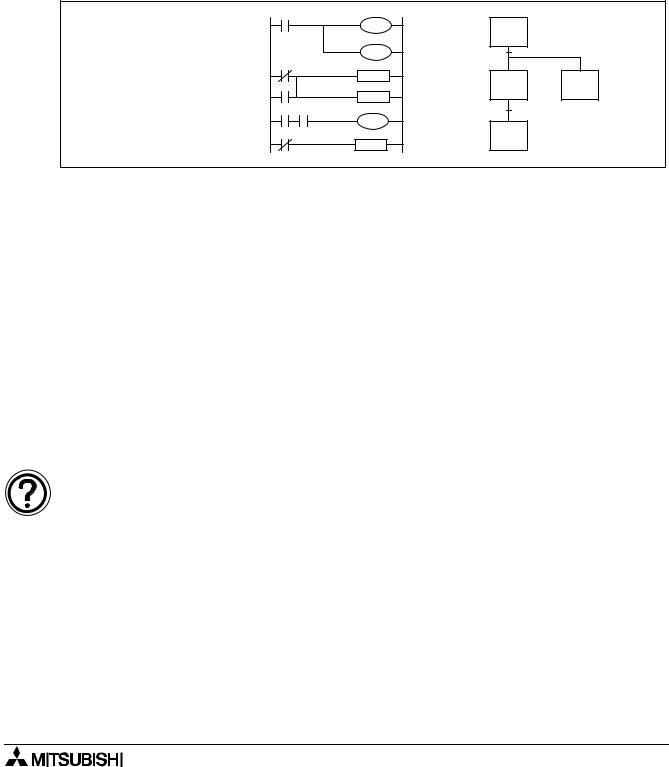
FX Series Programmable Controllers |
Basic Program Instructions 2 |
2.Basic Program Instructions
2.1What is a Program?
A program is a connected series of instructions written in a language that the PLC can understand. There are three forms of program format; instruction, ladder and SFC/STL. Not all programming tools can work in all programming forms. Generally hand held programming panels only work with instruction format while most graphic programming tools will work with both instruction and ladder format. Specialist programming software will also allow SFC style programming.
LD X10
OUT Y7
AND M38
SET S5
LD X21
OUT T01
K40
|
|
|
|
|
|
|
|
|
|
|
|
Instruction format |
Ladder Format |
SFC Format |
|||
2.2Outline of Basic Devices Used in Programming
There are six basic programming devices. Each device has its own unique use. To enable quick and easy identification each device is assigned a single reference letter;
-X: This is used to identify all direct, physical inputs to the PLC.
-Y: This is used to identify all direct, physical outputs from the PLC.
-T: This is used to identify a timing device which is contained within the PLC.
-C: This is used to identify a counting device which is contained within the PLC.
-M and S: These are used as internal operation flags within the PLC.
All of the devices mentioned above are known as ‘bit devices’. This is a descriptive title telling the user that these devices only have two states; ON or OFF, 1 or 0.
Detailed device information:
•Chapter 4 contains this information in detail. However, the above is all that is required for the rest of this chapter.
2-1

FX Series Programmable Controllers |
Basic Program Instructions 2 |
2.3How to Read Ladder Logic
Ladder logic is very closely associated to basic relay logic. There are both contacts and coils that can be loaded and driven in different configurations. However, the basic principle remains the same.
A coil drives direct outputs of the PLC (ex. a Y device) or drives internal timers, counters or flags (ex. T, C, M and S devices). Each coil has associated contacts. These contacts are available in both “normally open” (NO) and “normally closed” (NC) configurations.
The term “normal(ly)” refers to the status of the contacts when the coil is not energized. Using a relay analogy, when the coil is OFF, a NO contact would have no current flow, that is, a load being supplied through a NO contact would not operate. However, a NC contact would allow current to flow, hence the connected load would be active.
Activating the coil reverses the contact status, that is, the current would flow in a NO contact and a NC contact would inhibit the flow.
Physical inputs to the PLC (X devices) have no programmable coil. These devices may only be used in a contact format (NO and NC types are available).
Example:
Because of the close relay association, ladder logic programs can be read as current flowing from the left vertical line to the right vertical line. This current must pass through a series of contact representations such as X0 and X1 in order to switch the output coil Y0 ON. Therefore, in the example shown, switching X0 ON causes the output Y0 to also switch ON. If however, the limit switch X1 is activates, the output Y0 turns OFF. This is because the connection between the left and the right vertical lines breaks so there is no current flow.
|
|
|
|
|
|
Motor |
Toggle switch |
|
Programmable Controller |
|
|
|
|
|
|
|
|
|
||
X0 |
|
|
|
O |
Y0 |
|
I |
PC Program |
|
|
|||
|
U |
|
|
|||
|
N |
|
|
|||
|
|
|
|
|
||
|
|
|
T |
|
|
|
|
P |
X0 |
X1 |
|
|
|
|
P |
|
|
|||
|
U |
|
|
|
AC |
|
|
|
Y0 |
U |
COM |
||
X1 |
T |
|
||||
|
|
T |
Power |
|||
|
|
|
|
(Y0) |
Supply |
|
|
|
|
|
|
||
Limit switch |
|
|
|
|
|
|
|
|
DC Power Supply |
|
|
|
|
2-2
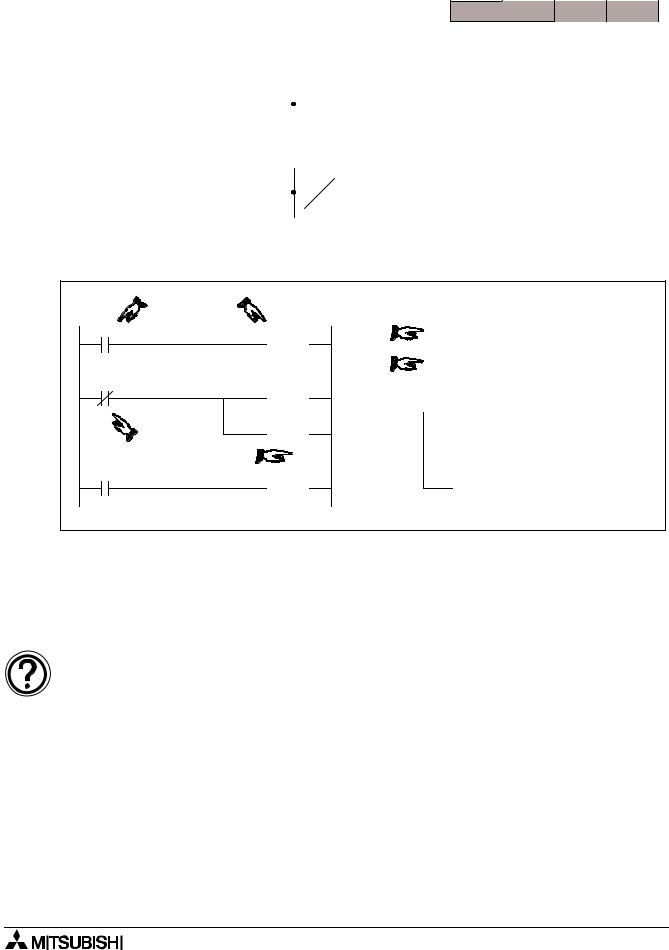
FX Series Programmable Controllers |
Basic Program Instructions 2 |
2.4Load, Load Inverse
FX1S |
FX1N |
FX2N |
FX2NC |
|
|
|
|
|
|
|
|
|
|
|
|
Mnemonic |
Function |
|
|
|
Format |
Devices |
Program steps |
|
|
|
|
Initial logical |
|
|
|
|
|
|
|
|
|
|
|
|
|
|
|
|
|
|
|
|
LD |
operation contact |
|
|
|
|
|
X, Y, M, S, T, C |
1 |
|
|
|
|
|
|
|
|
||||
|
(LoaD) |
type NO |
|
|
|
|
|
|
||
|
|
|
|
|
|
|
|
|
||
|
|
(normally open) |
|
|
|
|
|
|
|
|
|
|
|
|
|
|
|
|
|
|
|
|
|
|
|
|
|
|
|
|
|
|
|
|
Initial logical |
|
|
|
|
|
|
|
|
|
LDI |
operation contact |
|
|
|
|
|
X, Y, M, S, T, C |
1 |
|
|
|
|
|
|
|
|
||||
|
(LoaD Inverse) |
type NC |
|
|
|
|
|
|
||
|
|
|
|
|
|
|
|
|
||
|
|
(normally closed) |
|
|
|
|
|
|
|
|
|
|
|
|
|
|
|
|
|
|
|
|
|
|
|
|
|
|
|
|
|
|
Program example:
X0
|
Y0 |
|
X1 |
|
|
|
M100 |
|
LDI |
T0 |
|
K19 |
||
K |
||
T0 |
|
|
|
Y1 |
0 |
LD |
X |
0 |
1 |
OUT |
Y |
0 |
2 |
LDI |
X |
1 |
3 |
OUT |
M 100 |
|
4 |
OUT |
T |
0 |
|
SP |
K |
19 |
|
|||
7 |
LD |
T |
0 |
8 |
OUT |
Y |
1 |
When using hand held programmers, the space key needs to be pressed to enable the constant to be entered.
Basic points to remember:
-Connect the LD and LDI instructions directly to the left hand bus bar.
-Or use LD and LDI instructions to define a new block of program when using the ORB and ANB instructions (see later sections).
The OUT instruction:
•For details of the OUT instruction (including basic timer and counter variations) please see over the following page.
2-3
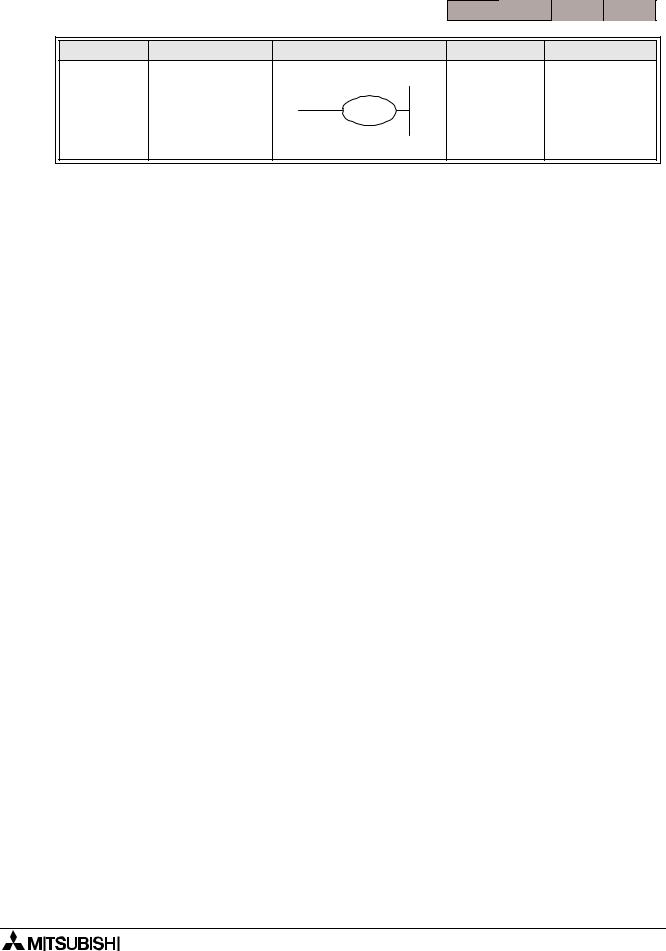
FX Series Programmable Controllers |
Basic Program Instructions 2 |
2.5Out
FX1S |
FX1N |
FX2N |
FX2NC |
Mnemonic |
Function |
Format |
Devices |
Program steps |
|
|
|
|
Y, M:1 |
|
Final logical |
|
|
S, special M |
OUT |
|
|
coils: 2 |
|
operation type coil |
|
Y, M, S, T, C |
||
(OUT) |
|
T:3 |
||
drive |
|
|
||
|
|
|
C (16 bit): 3 |
|
|
|
|
|
|
|
|
|
|
C (32 bit): 5 |
Basic points to remember:
-Connect the OUT instruction directly to the right hand bus bar.
-It is not possible to use the OUT instruction to drive ‘X’ type input devices.
-It is possible to connect multiple OUT instructions in parallel (for example see the previous page; M100/T0 configuration)
2.5.1Timer and Counter Variations
When configuring the OUT instruction for use as either a timer (T) or counter (C) a constant must also be entered. The constant is identified by the letter “K” (for example see previous page; T0 K19).
In the case of a timer, the constant “K” holds the duration data for the timer to operate, i.e. if a 100 msec timer has a constant of “K100” it will be (1005 100 msec) 10 seconds before the timer coil activates.
With counters, the constant identifies how many times the counter must be pulsed or triggered before the counter coil activates. For example, a counter with a constant of “8” must be triggered 8 times before the counter coil finally energizes.
The following table identifies some basic parameter data for various timers and counters;
|
Timer/Counter |
Setting constant K |
Actual setting |
Program steps |
|
|
1 msec Timer |
|
0.001 to 32.767 sec |
|
|
|
|
|
|
|
|
|
10 msec Timer |
1 to 32,767 |
0.01 to 327.67 sec |
3 |
|
|
|
|
|
|
|
|
100 msec Timer |
|
0.1 to 3276.7 sec |
|
|
|
|
|
|
||
|
|
|
|
|
|
|
16 bit Counter |
1 to 32,767 |
1 to 32,767 |
|
|
|
|
|
|
|
|
|
32 bit Counter |
-2,147,483,648 to |
-2,147,483,648 to |
5 |
|
|
2,147,483,647 |
2,147,483,647 |
|
||
|
|
|
|
||
|
|
|
|
|
|
|
|
|
|
|
|
2-4
